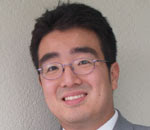Management by Not Having Any - A Key to Innovation?
 I just attended a workshop co-hosted by Ralph Kerle of the Creative Leadership Forum and was struck by his discussion of Arup.
I just attended a workshop co-hosted by Ralph Kerle of the Creative Leadership Forum and was struck by his discussion of Arup. Who?
Well, if you spent a significant amount of time watching the Beijing Olympics this year you may have seen their work: The Water Cube- The National Aquatics Center where the swimming events were held. Other projects to their credit include The Sydney Opera House and the Millennium Bridge in London.
Arup is an engineering firm... of sorts. Actually it is an organization held in trust for its 9000 staff members including engineers, architects, designers and consultants in over 37 countries. There are no shareholders and no discernable management structure. Yet, they manage to work on over 10,000 at any one time and build some of the most memorable and innovative structures in the world today.
One might call them innovators.
As Ralph Kerle wrote in his article Creative Leadership and the Water Cube at the Beijing Olympics,
... innovation in the building industry is very difficult... Every building is a prototype that mustn't fail. In structural engineering, you just cannot fail or the building will fall down.
This might lead to the conclusion that engineering firms must remain risk adverse at all costs, but risk adverse doesn't mean and mustn't mean forgoing innovation, for one important reason.
The production of the basic building materials on which our civilization exists is depleting our natural resources. As the global population rushes towards 9 billion, our consumption is exceeding our resources. The destruction of the rainforests, the depletion of oil supplies, the failure to find reliable energy alternatives and food shortages offer compelling evidence of this occurring.
The lead in changing the risk-adverse paradigm in the building industry therefore falls to innovative firms like Arup. Founded by Ove Arup, a philosophy and mathematics major from Copenhagen, Arup is unique in its management approach and its business philosophy which might just be little different than what I claimed here was one of my favorite quotes:
"Opportunity is missed by most people because it is dressed in overalls and looks like work." Thomas Edison.
At Arup, new employees are introduced to the firm philosophy and encouraged to go and seek out projects that hold his or her interest. The new employee is expected to be innovative and creative and a full fledged partner in the project, as all team members are.
Ove Arup's philosophy is the guiding principle that enables the company to create such beautiful, innovative and practical structures.
Arup recognised individuals as being innately creative. He reasoned if you provided employees with the simple humanitarian conditions of self organisation and creative freedom, an employer gained loyalty, respect and integrity from the employee, these values became recognised and respected by stakeholders and as a consequence the organisation was seen as reasonable, reliable and ethical.
Is this philosophy transferable to other types of companies? Of course and it must be because we are all faced with a global crisis in the making, as our natural resources are depleted.
Is this philosophy and management structure the only way to create innovative products. Of course not, but providing employees with an environment where they are valued for their creativity; their input is solicited and where they work on projects they like is certainly one way that's worth trying.
Labels: Arup, Creative Leadership Forum, innovation, management, Ralph Kerle




0 Comments:
Post a Comment
<< Home